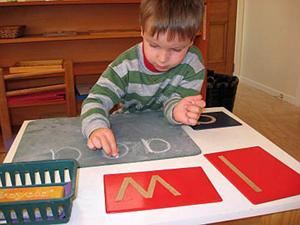By: Rob Gueterbock

The introduction of the Early Years Foundation Stage (EYFS) has created an opportunity for a new relationship between the Montessori movement in the UK and those academics, policy makers and local authority professionals involved in the care and education of young children. There is a strong concordance between the themes and principles that underpin the EYFS and those that guide Montessori practice.
Introduction
Drawing on the Birth to Three Matters Framework, the EYFS puts a new emphasis on children as active learners throughout the foundation stage. This new emphasis has in turn increased the attention given to the environments from which children learn. Dr Montessori was one of the earliest pioneers of educational practices based on these ideas. Today, Montessori communities have a unique contribution to make to the delivery of the EYFS because of the very different way in which they function to support active learning.
At the same time the EYFS poses a difficulty, in the form of the statutory targets, to those seeking to comprehensively support active learning. Over many years children in Montessori environments have comfortably arrived at the indicators of development described through the targets. Supporting children to this level of development has come about by planning activities that follow each child’s deepest interests at any particular time. The emphasis on target-based planning within the EYFS could lead some practitioners to dictate a learning timetable to the children at the expense of following the deep interests of an active learner.
Montessori Education (UK) have written a document mapping Montessori against the guidelines given in the EYFS. The purpose of this document is to highlight how the EYFS can be delivered very effectively through Montessori environments, highlighting those areas where Montessori practice has a particular contribution to offer. Each of the Themes and Principles is comprehensively addressed, including the six areas of Learning and Development.
Montessori and the EYFS
A central idea of Montessori education is that children have within them the power they need to develop themselves. Following from this is the understanding that it is through the child's interaction with his environment that this self-construction takes place. It is the child that needs to be active in his dynamic experience with the world around him. The task we set ourselves as Montessori educators is to provide children with an environment carefully prepared to meet their particular developmental needs and, through careful observation, to connect them with that environment, so that they can build themselves through their own activity.
The parallels between the Montessori approach and some of the main themes of the Early Years Foundation Stage (EYFS) are clear. The EYFS theme of 'A Unique Child' is based on the principle that 'Every child is a competent learner from birth who can be resilient, capable, confident and self-assured'. Similarly the EYFS makes the provision of 'Enabling Environments' one of four priorities. The emphasis placed on 'active learning' and 'learning through experience' within the theme of 'Learning and Development' is again very much in line with Montessori practice.
There are many sections of the EYFS that emphasize the importance of the child's own decision making, both in what they do and how they do it. Other parts of the EYFS emphasize that children are innately 'primed' to learn from the human and physical environments around them. This is a radical departure from traditional educational practice, which in general follows a curriculum decided by the adult, that determines what the children should do and learn. In the Montessori approach decision-making for the child's day-to-day activities shifts away from the adult, to the child.
Montessori environments take these principles to their natural conclusion. The child enters an environment, which both in its contents and functioning is designed to meet the particular physical, mental and spiritual needs of children aged between 2 ½ to 6 years. Within this space there are very few limits to the child's freedom and decision-making. A child is shown a variety of activities, is free to choose what to do, and for how long. Through detailed observations of his choice and use of activities, further individual lessons are offered, giving him an increasing range of materials to explore. Children are free to use an activity until they decide to put it away. They are free to choose when to be active, when to rest and watch, when to look at a book, to go outside, to have a drink or prepare some fruit. When a child is choosing freely within an environment carefully prepared to support his independence, it is relatively easy to observe his real interests unfolding – those that are driven by developmental urges - and to support and follow these.